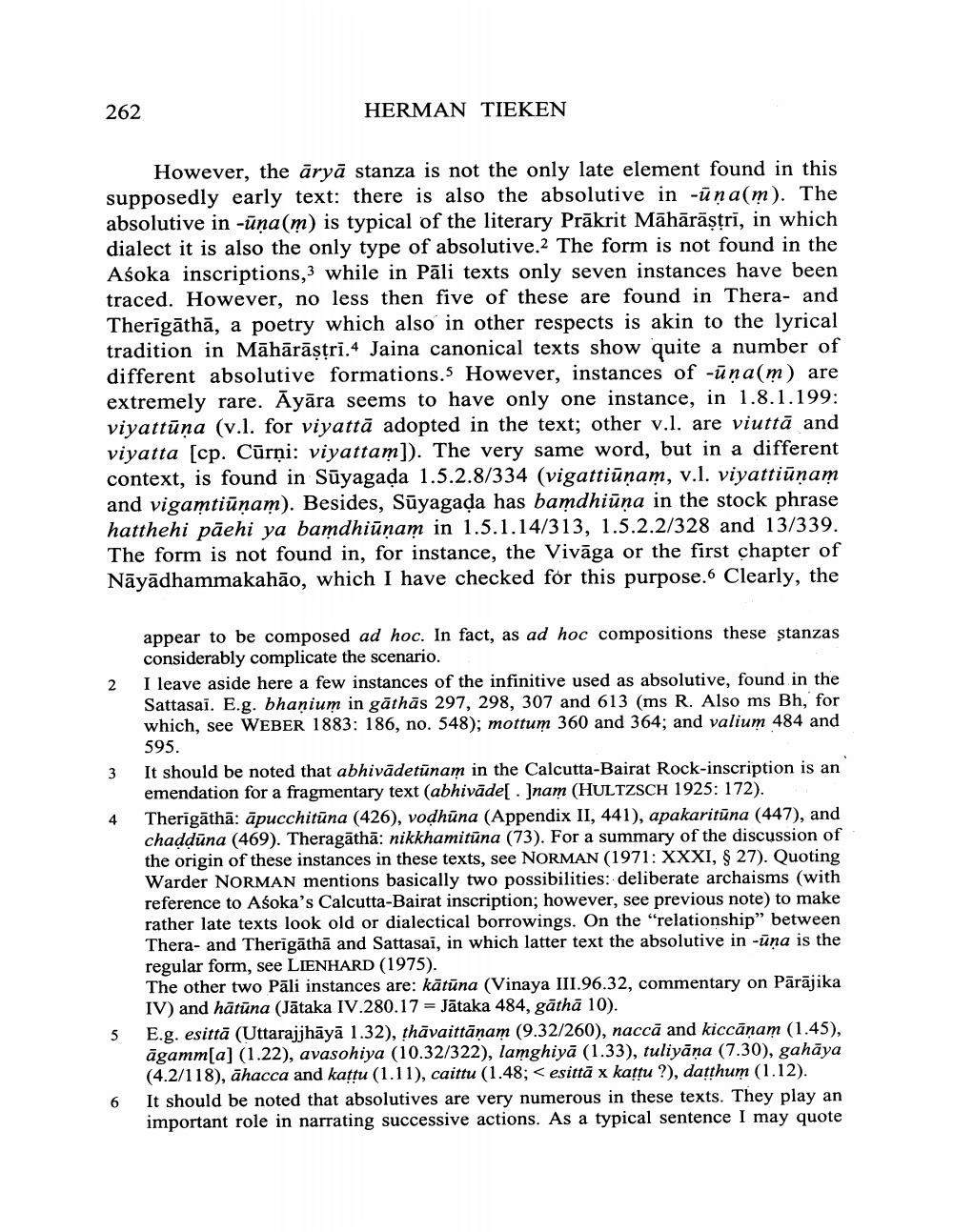Book Title: Distribution Of Absolutive In Una In Ittarajjhaya Author(s): Herman Tieken Publisher: Herman Tieken View full book textPage 2
________________ 262 HERMAN TIEKEN However, the āryā stanza is not the only late element found in this supposedly early text: there is also the absolutive in -ūna(m). The absolutive in -ūņa(m) is typical of the literary Prākrit Māhārāstrī, in which dialect it is also the only type of absolutive. The form is not found in the Asoka inscriptions,3 while in Pāli texts only seven instances have been traced. However, no less then five of these are found in Thera- and Therīgāthā, a poetry which also in other respects is akin to the lyrical tradition in Māhārāștri.4 Jaina canonical texts show quite a number of different absolutive formations. However, instances of -ūņa(m) are extremely rare. Āyāra seems to have only one instance, in 1.8.1.199: viyattūņa (v.l. for viyattă adopted in the text; other v.l. are viuttā and viyatta [cp. Cūrņi: viyattam]). The very same word, but in a different context, is found in Sūyagada 1.5.2.8/334 (vigattiūņam, v.1. viyattiūņam and vigamtiūņam). Besides, Sūyagada has bamdhiūna in the stock phrase hatthehi pāehi ya bamdhiūņam in 1.5.1.14/313, 1.5.2.2/328 and 13/339. The form is not found in, for instance, the Vivāga or the first chapter of Nāyādhammakahāo, which I have checked for this purpose.6 Clearly, the 3 appear to be composed ad hoc. In fact, as ad hoc compositions these stanzas considerably complicate the scenario. I leave aside here a few instances of the infinitive used as absolutive, found in the Sattasai. E.g. bhanium in gāthās 297, 298, 307 and 613 (ms R. Also ms Bh, for which, see WEBER 1883: 186, no. 548); mottum 360 and 364; and valium 484 and 595. It should be noted that abhivādetūnam in the Calcutta-Bairat Rock-inscription is an emendation for a fragmentary text (abhivādel . ]nam (HULTZSCH 1925: 172). Therīgāthā: āpucchitūna (426), vodhūna (Appendix II, 441), apakaritūna (447), and chaddūna (469). Theragāthā: nikkhamitūna (73). For a summary of the discussion of the origin of these instances in these texts, see NORMAN (1971: XXXI, § 27). Quoting Warder NORMAN mentions basically two possibilities: deliberate archaisms (with reference to Asoka's Calcutta-Bairat inscription; however, see previous note) to make rather late texts look old or dialectical borrowings. On the “relationship" between Thera- and Therigāthā and Sattasai, in which latter text the absolutive in -ūna is the regular form, see LIENHARD (1975). The other two Pāli instances are: kātūna (Vinaya III.96.32, commentary on Pārājika IV) and hātūna (Jātaka IV.280.17 = Jātaka 484, gātā 10). E.g. esittā (Uttarajjhāyā 1.32), thāvaittānam (9.32/260), naccā and kiccānam (1.45), āgamm[a] (1.22), avasohiya (10.32/322), lamghiyā (1.33), tuliyāņa (7.30), gahāya (4.2/118), āhacca and kattu (1.11), caittu (1.48; <esittă x kattu ?), datthum (1.12). It should be noted that absolutives are very numerous in these texts. They play an important role in narrating successive actions. As a typical sentence I may quote 5 6Page Navigation
1 2 3 4 5 6 7 8 9 10 11 12 13 14 15 16 17 18 19 20 21 22 ... 26
